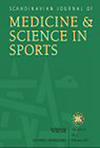挪威妇女使用激素避孕药的流行率和归因于月经周期或激素避孕药使用的自我报告症状经历:培训类别和年龄组的影响- FENDURA项目
IF 3.8
2区 医学
Q1 SPORT SCIENCES
引用次数: 0
摘要
当前研究的目的是(1)报告不同培训类别和年龄组的挪威妇女使用激素避孕药(HC)的流行情况;(2)比较不同训练类别和年龄组中周期相关症状的频率和严重程度;(3)描述非HC使用者的出血模式和月经紊乱/紊乱的患病率。2059名挪威妇女完成了一项调查报告:每周训练量;目前HC的使用情况、类型和使用原因;周期相关症状的频率和严重程度;以及月经紊乱/紊乱的患病率。受访者按年龄分类(青少年:13-20岁;年轻人:21-30岁;老年人:31-50岁)和训练组(最小:0;低:& lt;5;中度:5 - 9;高:≥9 h·周−1)。一半(51.6%)的应答者报告目前使用HC,主要是长效可逆避孕或联合口服避孕药。与年轻人(48.4%)和老年人(43.8%)相比,年轻人(62.7%)使用HC的比例最高,尽管不同培训类别的使用情况没有差异。与非丙肝使用者相比,丙肝使用者报告的周期相关症状较少且较轻。三分之一(30.8%)的非HC使用者经历过月经紊乱/障碍,在训练类别或年龄组中没有观察到显著差异。总之,HC的使用在挪威妇女中很普遍,在培训类别之间没有差异。这种相似的HC患病率表明,在女性队列中进行的HC研究可能是可推广的,独立于训练类别。然而,由于不同年龄组之间HC使用的差异,应注意参与者的年龄。本文章由计算机程序翻译,如有差异,请以英文原文为准。
Prevalence of Hormonal Contraceptive Use and Self‐Reported Symptomatic Experiences Attributed to the Menstrual Cycle or Hormonal Contraceptive Use in Norwegian Women: The Effect of Training Categories and Age Groups ‐ The FENDURA Project
The aims of the current study were to (1) report the prevalence of hormonal contraceptive (HC) use among Norwegian women across different training categories and age groups; (2) compare the frequency and severity of cycle‐related symptoms across differing training categories and age groups; and (3) describe the bleeding pattern and prevalence of menstrual disorder/disturbances among non‐HC users. A sample of 2059 Norwegian women completed a survey reporting: weekly training volume; current HC usage, type, and reasons for use; cycle‐related symptom frequency and severity; and the prevalence of menstrual disorders/disturbances. Respondents were categorized by age (youth: 13–20; young adults: 21–30; older adults: 31–50 years) and training category (minimal: 0; low: < 5; moderate: 5–9; high: ≥ 9 h·week−1 ). Half (51.6%) of respondents reported current HC usage, predominantly long‐acting reversible contraception or combined oral contraceptives. Young adults had the highest prevalence of HC use (62.7%) compared to youth (48.4%) and older adults (43.8%), although no differences in usage were seen across training categories. HC users reported fewer and less severe cycle‐related symptoms compared to non‐users. A third (30.8%) of non‐HC users had experienced a menstrual disorder/disturbance, with no significant differences observed across training categories or age groups. In conclusion, HC use is widespread among Norwegian women, with no differences between training categories. This similar HC prevalence suggests that HC research conducted in female cohorts may be generalizable, independent of training category. However, attention should be paid to participants' age due to differences in HC use between age groups.
求助全文
通过发布文献求助,成功后即可免费获取论文全文。
去求助
来源期刊
CiteScore
7.90
自引率
4.90%
发文量
162
审稿时长
3 months
期刊介绍:
The Scandinavian Journal of Medicine & Science in Sports is a multidisciplinary journal published 12 times per year under the auspices of the Scandinavian Foundation of Medicine and Science in Sports.
It aims to publish high quality and impactful articles in the fields of orthopaedics, rehabilitation and sports medicine, exercise physiology and biochemistry, biomechanics and motor control, health and disease relating to sport, exercise and physical activity, as well as on the social and behavioural aspects of sport and exercise.

 求助内容:
求助内容: 应助结果提醒方式:
应助结果提醒方式:


